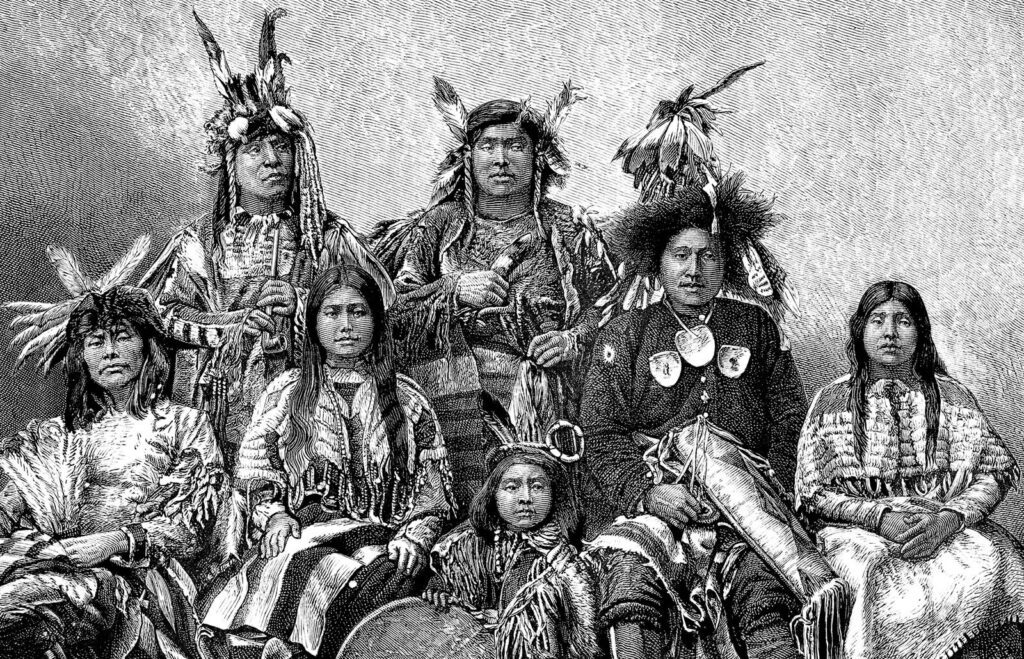Development of America: A Land of Opportunity and Change
A Nation on the Move
The period between 1840 to 1895 saw America transform from a collection of states along the Atlantic coast to a nation that spanned the entire continent. As the nation grew, it was like a vast puzzle coming together piece by piece. Driven by the belief in ‘Manifest Destiny‘, Americans believed they were destined to populate and control this expansive land.
Challenges of Expansion
Expansion was far from straightforward. The lands were already inhabited by indigenous communities, the Native Americans. As settlers moved westward, they encountered these communities, leading to cultural exchanges and, at times, confrontations.
The Melting Pot of Cultures
The promise of new opportunities attracted a diverse range of settlers. Pioneers seeking farmland, gold-seekers, and communities like the Mormons all converged, making America a melting pot of cultures and ambitions.
Laying the Foundations
Beyond territorial growth, America was also establishing its political and economic structures. The American Civil War in the mid-19th century highlighted the challenges of nation-building, with differences in economic interests, views on slavery, and the debate over state versus federal rights. This conflict, though brutal, paved the way for a more united nation.
Key Areas of Focus in America, 1840–1895
Political Developments
During this period, America was figuring out its governance structure. This was a time of defining what kind of democracy the United States would be. Important events, like the American Civil War, were as much about politics as they were about socio-economic differences. The balance of power between states and the federal government was a significant debate, influencing policies and leading to various amendments in the constitution.
Economic Growth
The 19th century was pivotal for America’s economic transformation. The westward expansion wasn’t just about land—it was also about resources. The discovery of gold sparked rushes and migrations, while the vast plains offered agricultural opportunities. Railroads began to crisscross the nation, acting as the arteries of a growing economic body, transporting goods, people, and ideas.
Social Changes
As settlers moved across the continent, they brought with them their traditions, cultures, and social norms. This period saw a blending and sometimes clashing of cultures, from the European settlers to the Native Americans. Society was also grappling with the moral and practical implications of slavery, leading to tensions between the North and South.
Cultural Aspects
America, with its vastness, began developing regional cultures. The traditions of the East Coast melded with the frontier spirit of the West. Literature, art, and music of this era reflected the nation’s growth, struggles, and aspirations. From the writings of Mark Twain capturing the essence of life along the Mississippi to the paintings portraying the majestic landscapes of the West, culture was an essential reflection of the times.
Role of Ideas
Ideas were the catalysts for change. The belief in ‘Manifest Destiny’ drove expansion, while debates about liberty, equality, and state rights shaped policies and political movements. Ideas about economy, such as the gold standard, influenced financial systems, and concepts of individual rights led to significant legal and societal reforms.
Key Individuals and Groups
This era was marked by leaders, visionaries, and everyday people making a difference. Figures like Abraham Lincoln, who navigated the nation through its darkest hours, or groups like the pioneers and the Native Americans, each played their part in shaping the nation’s trajectory.
Impact of Developments
Every development, be it political, economic, or social, had its consequences. The expansion westward brought prosperity for some but led to the displacement of Native American communities. Similarly, while the industrial growth in the North bolstered its economy, it created stark differences with the agrarian South.
Geography of North America

Landscape and Diversity
North America, when we talk about its geography, is a tapestry of varied landscapes. From the frozen tundras of the north to the sun-kissed beaches of the south, it offers a diverse range of ecosystems. The continent is flanked by the Atlantic Ocean to the east and the Pacific Ocean to the west, giving it a vast coastal line.
The Great American Desert
Contrary to its name, the Great American Desert wasn’t a desert in the Sahara sense. It referred to the arid region, primarily the Great Plains, which stretches across the central part of the United States. Early explorers and settlers once believed these areas to be barren and unsuitable for agriculture. However, with time, methods like dry farming made cultivation possible, turning these plains into significant agricultural zones.
Mountains, Rivers, and Lakes
The Rocky Mountains, spanning the western part of the continent, are a dominant feature, influencing weather patterns and acting as a natural barrier. In contrast, the central and eastern parts of North America are crisscrossed by major rivers like the Mississippi and the Missouri. The Great Lakes, situated in the northeast, are another significant geographical feature, holding some of the largest freshwater reserves in the world.
Climate and Vegetation
Given its vastness, North America has a diverse climate. The northern regions, closer to the Arctic, are cold and snowy, while the southern areas have a warmer, tropical climate. This climatic diversity has given rise to varied vegetation zones, from dense forests in the Pacific Northwest to grasslands in the central plains and rainforests in Central America.
Human Settlement and Expansion
The diverse geography of North America played a significant role in shaping human settlements. While the eastern coastal regions were more densely populated due to early European settlements, the vast interiors and the west remained largely unexplored until the 19th century. The idea of the ‘Manifest Destiny’ spurred westward movement, leading to the discovery and settlement of these interior regions.

Jonas T.
English | History | Geography Tutor
Student at UNIVERSITY OF OXFORD
£26 Per session
Book Free TrialManifest Destiny
Origins of the Term
“Manifest Destiny” is a term that originated in the 19th century, and it encapsulated the belief that it was the divine destiny of the United States to expand its territory and influence across North America. The term itself was coined by journalist John L. O’Sullivan in 1845, but the sentiment it expressed had been a driving force behind American expansionism for decades.
Belief in Expansion
At its core, Manifest Destiny was rooted in the belief that American expansion was both justified and inevitable. Proponents argued that it was the duty of the U.S. to spread its democratic ideals, institutions, and culture across the continent, from the Atlantic to the Pacific.
Influence on Policy
This ideology had a profound impact on U.S. domestic and foreign policies. It provided the moral and ideological justification for territorial acquisitions, whether through purchase, negotiation, or conflict. For instance, the annexation of Texas, the Oregon Trail, and the Mexican-American War can all be seen in the light of Manifest Destiny.
Controversies and Implications
While Manifest Destiny was a popular belief among many, it wasn’t without its detractors and controversies. The expansion led to significant displacement and suffering for Native American populations. It also intensified the debate over slavery, as questions arose about whether new territories and states would permit the institution.
Cultural Impact
Manifest Destiny wasn’t just a political ideology; it permeated American culture. It was reflected in art, literature, and popular discourse. Paintings of the era often portrayed the westward expansion as a divine and enlightening journey, with settlers moving into vast, untouched landscapes bathed in radiant light.
Legacy
While the term “Manifest Destiny” fell out of popular use by the end of the 19th century, its influence endured. The belief in American exceptionalism and the country’s role on the global stage can be traced back, in part, to the ideas encapsulated by Manifest Destiny.
Plains Indians

The Plains Indians were a diverse group of Native American tribes that inhabited the Great Plains, a vast region stretching from present-day Canada down to Texas. These tribes were known for their nomadic lifestyle, reliance on buffalo hunting, and distinct cultural practices.
Lifestyle and Economy
- Nomadic Existence: Many Plains tribes led a nomadic life, moving frequently in search of buffalo herds. Their homes, known as tipis, were easily constructed and dismantled, making them suitable for this mobile lifestyle.
- Buffalo Centric: The buffalo was central to the Plains Indians’ way of life. They relied on it for food, clothing, shelter, and tools. Every part of the buffalo was utilised, reflecting the tribes’ sustainable approach to nature.
Cultural Practices
- Religion and Spirituality: The Plains Indians held a deep spiritual connection to the land and its creatures. Rituals, like the Sun Dance, were pivotal in seeking spiritual guidance and giving thanks to the Great Spirit.
- Warfare and Societal Structure: Tribes often engaged in inter-tribal warfare, primarily for hunting rights or to settle disputes. Warriors held a respected position in society, with feats in battles often depicted through intricate beadwork or paintings on hides and tipis.
- Art and Craft: From feathered headdresses to beadwork, Plains Indian art was both functional and symbolic. Their crafts often depicted stories, beliefs, or significant events.
Relations with Settlers
As American settlers pushed westward, the Plains Indians’ traditional way of life came under threat.
- Treaties and Reservations: The U.S. government attempted to establish treaties with various tribes, designating specific lands for them called reservations. However, many of these treaties were broken or renegotiated under less favourable terms for the Native Americans.
- Conflicts: With the encroachment of settlers and the U.S. army, conflicts were inevitable. Battles like the Battle of Little Bighorn saw significant confrontations between the U.S. army and the Plains tribes.
- Assimilation Efforts: In addition to physical displacement, there were efforts to assimilate the Plains Indians into American culture, which involved eradicating their native languages, traditions, and spiritual practices.
Legacy and Modern Day
While the traditional nomadic lifestyle of the Plains Indians has largely ceased, their cultural practices, stories, and beliefs continue to be celebrated and passed down through generations. Today, many descendants live on reservations, and there’s a renewed interest in reviving and preserving their rich heritage.
Conflict on the Plains
As the United States expanded westward in the 19th century, driven by the belief in Manifest Destiny, the settlers encountered the native inhabitants of the Great Plains—the Plains Indians. This meeting of two vastly different cultures and ways of life set the stage for a series of conflicts.
Tensions Rise
- Land and Resources: As settlers moved into the plains, they began to claim lands traditionally used by the Plains Indians, especially for buffalo hunting. This led to competition and tensions over vital resources.
- Cultural Differences: Settlers often misunderstood or dismissed the Plains Indians’ nomadic lifestyle, spiritual beliefs, and societal structures. This lack of understanding and respect further exacerbated tensions.
Treaties and Broken Promises
- Fort Laramie Treaty (1851): One of the early attempts to establish peace, this treaty aimed to define territories for each tribe and allow safe passage for settlers along the Oregon Trail. In exchange, the U.S. government promised annual payments to the tribes. However, the influx of settlers and gold-seekers soon violated these boundaries.
- Policy of Concentration: This policy aimed to limit tribes to specific areas to avoid conflict with settlers. Yet, it often disregarded traditional tribal territories and was inadequately enforced.
Escalation to War
- Indian Wars (1862–1867): As tensions reached a boiling point, a series of conflicts erupted between the U.S. military and various Plains tribes. These wars were marked by battles, skirmishes, and massacres on both sides.
- Notable Conflicts:
- Sand Creek Massacre: In a tragic event, U.S. troops attacked a peaceful camp of Cheyenne and Arapaho, leading to significant loss of life, primarily among women, children, and the elderly.
- Fetterman’s Trap: A conflict between the U.S. army and Lakota Sioux, this event was one of the many confrontations over control of the Bozeman Trail.
The Impact of Conflict
- Displacement of Tribes: As a result of these conflicts and subsequent treaties, many tribes were relocated to reservations, often on lands less fertile and far from their traditional territories.
- Decline of the Buffalo: Settlers and hunters began to hunt buffalo in large numbers, both for sport and to weaken the Plains Indians. The near extinction of the buffalo deeply affected the tribes, as these animals were central to their way of life.
Towards a Fragile Peace
The latter part of the 19th century saw a reduction in direct military confrontations, but tensions persisted. Efforts were made to assimilate Plains Indians into American society, further eroding their traditional way of life.
American Civil War
Prelude to War
The American Civil War, fought from 1861 to 1865, was a defining moment in U.S. history. Its roots lay in deep-seated economic, political, and social differences between the North and the South.
- Economic Differences: The North was rapidly industrialising, becoming more urban and reliant on factories and infrastructure. In contrast, the South remained primarily agrarian, with an economy heavily dependent on large-scale farming and slave labour.
- Slavery: The most divisive issue was slavery. While many northern states had abolished or were moving away from the institution, the southern states viewed slavery as vital to their economy and way of life.
- States’ Rights vs Federal Authority: The South championed the rights of individual states to determine their laws and practices, resisting federal intervention, especially regarding slavery.
Flashpoints Leading to War
Several events heightened tensions and pushed the nation closer to conflict:
- Missouri Compromise: An early effort to maintain a balance between slave and free states, it admitted Missouri as a slave state and Maine as a free state.
- Westward Expansion: As new territories were acquired, the question arose: would they permit slavery? The debate over territories like Kansas and Nebraska was particularly intense.
- John Brown’s Raid: Abolitionist John Brown’s attempt to start a slave revolt by seizing a federal arsenal at Harpers Ferry further inflamed passions.
- Election of Abraham Lincoln: The 1860 election of Lincoln, who the South viewed as anti-slavery, was the final straw for many southern states.
The War Unfolds
- Secession: Starting with South Carolina in December 1860, eleven southern states seceded from the Union, forming the Confederate States of America with Jefferson Davis as its president.
- Major Battles: The war saw several significant battles, including Bull Run, Antietam, Gettysburg, and Vicksburg. These battles were often bloody and decisive, shaping the war’s course.
- Emancipation Proclamation: In 1863, Lincoln issued this proclamation, declaring the freedom of all slaves in Confederate-held territory. While its immediate effect was limited, it transformed the war’s nature, making it a fight against slavery.
End of the War and Aftermath
- Surrender: After four years of intense conflict, General Robert E. Lee of the Confederacy surrendered to Union General Ulysses S. Grant at Appomattox Court House in 1865.
- Reconstruction: Post-war, the U.S. embarked on a challenging period of Reconstruction, trying to integrate the Confederate states back into the Union and defining the status of freed slaves.
- Legacy: The war had profound impacts. Slavery was abolished, the federal government’s power over states was affirmed, and the nation began its slow process of healing and unification.
Mormons
Origins and Beliefs
The Mormons, officially known as the Church of Jesus Christ of Latter-day Saints, was founded in the early 19th century by Joseph Smith. Smith claimed to have been visited by God and Jesus Christ and later translated the Book of Mormon, an additional scripture alongside the Bible.
- Beliefs: Mormons hold many beliefs in common with other Christian denominations but have distinct doctrines too, such as the concept of modern-day prophecy and the importance of the Book of Mormon.
- Priesthood: Within the church, a system of priesthood authority exists. Men can be ordained to various levels of the priesthood, allowing them to perform specific duties and rituals.
Persecution and Migration
- Early Years: From its inception, the church faced significant opposition and persecution. Their unique beliefs, combined with their rapid growth and sometimes unconventional practices (like polygamy), led to tensions with non-Mormon communities.
- Migration West: Due to mounting pressures, including the assassination of Joseph Smith, the Mormons decided to leave their settlements in the eastern and central United States. Led by Brigham Young, they embarked on a significant migration westward.
- Journey to Utah: Facing a challenging journey across the plains, mountains, and deserts, the Mormons eventually settled in the Salt Lake Valley in present-day Utah. Here, they established a thriving community, and Salt Lake City became the church’s headquarters.
Challenges and Integration
- Tensions with the U.S. Government: Even in their new home, the Mormons faced challenges. Their practice of polygamy and their theocratic style of governance led to conflicts with the U.S. government.
- Mountain Meadows Massacre: One of the dark chapters in Mormon history, this event in 1857 saw a group of Mormons and Native American allies attack a wagon train of settlers, leading to significant loss of life.
- End of Polygamy: Facing increasing pressures, the church officially renounced the practice of polygamy in 1890, paving the way for Utah’s statehood.
Modern Day and Growth
- Global Church: From its origins in the United States, the church has grown into a global religion with millions of members worldwide.
- Missionary Work: One of the hallmarks of the church is its emphasis on missionary work. Young Mormons often spend two years abroad, spreading their faith and doing community service.
- Cultural Impact: The Mormons have had a significant cultural impact, especially in the U.S., from the world-renowned Tabernacle Choir to institutions like Brigham Young University.
Post-Civil War Era
Reconstruction (1865-1877)
After the Civil War’s end, the United States embarked on the challenging task of rebuilding and reintegrating the Southern states into the Union, a period known as Reconstruction.
- Presidential vs. Radical Reconstruction: There were differing views on how Reconstruction should proceed. While Presidents like Andrew Johnson favoured a lenient approach towards the South, Radical Republicans in Congress sought stricter measures and protections for newly freed slaves.
- Amendments and Rights: The 13th, 14th, and 15th Amendments were ratified during this period, abolishing slavery, guaranteeing citizenship and equal protection under the law, and ensuring voting rights regardless of race.
- Rise of the Ku Klux Klan: Resistance to Reconstruction and racial equality led to the formation of groups like the Ku Klux Klan, which used terror to suppress black rights and Republican influence in the South.
Economic Transformation
- Industrialisation: The post-war period saw rapid industrial growth, especially in the North. Innovations in machinery, transportation, and communication transformed the economy.
- Expansion of Railroads: Railroads played a pivotal role, connecting the vast country and enabling the movement of goods and people. This led to the growth of towns and cities along the routes.
The Westward Push
- Homestead Act (1862): This act encouraged westward migration by providing settlers with 160 acres of public land. In exchange, settlers were required to complete five years of continuous residence and cultivate the land.
- Native American Displacement: The westward expansion came at a significant cost to Native American tribes, leading to further displacement and conflicts, such as the Battle of Little Bighorn in 1876.
Social Changes
- Jim Crow Laws: In the latter part of the 19th century, Southern states enacted Jim Crow laws, instituting racial segregation and disenfranchising black citizens. These laws would remain in place for nearly a century, shaping racial dynamics in the U.S.
- Immigration: The post-war era saw significant waves of immigration, particularly from Europe. Cities like New York and Chicago saw their populations swell, adding to the cultural mosaic of the nation.
Cultural Evolution
- Literature and Arts: Authors like Mark Twain captured the spirit and complexities of post-war America. In the arts, movements like the Hudson River School celebrated the country’s natural beauty.
- Education and Reform: There was a push for public education and various social reforms, from temperance movements to women’s suffrage campaigns.
Settlement of the West
The Allure of the West
The vast expanse of the American West, with its promise of fertile lands, mineral wealth, and a fresh start, beckoned settlers from the eastern states and beyond. This period of westward expansion was driven by a combination of economic opportunity, personal ambition, and the enduring belief in Manifest Destiny.
Pioneers and Homesteaders
- Homestead Act of 1862: This legislation played a pivotal role in the westward movement. It allowed any American, including freed slaves, to put in a claim for up to 160 acres of federal land. In return, they had to cultivate the land and build a dwelling.
- Challenges Faced: The journey west was fraught with challenges, from treacherous terrain to unpredictable weather and potential conflicts with Native American tribes. Yet, the promise of a new beginning drove thousands to take the risk.
Gold Rushes and Boomtowns
- California Gold Rush (1848-1855): The discovery of gold in California drew a flood of prospectors and settlers hoping to strike it rich. Towns sprang up overnight, only to be abandoned once the gold ran out.
- Silver, Copper, and More: While gold was the most famous, other mineral rushes, including silver in Nevada and copper in Montana, further accelerated western settlement.
Railroads – The Iron Horse
- Transcontinental Railroad: Completed in 1869, this engineering marvel connected the coasts and opened the West to more significant settlement and commerce. Railroads brought goods, people, and ideas, shrinking the vast distances.
- Land Grants: To incentivise railroad construction, the U.S. government provided companies with land grants. These lands were often sold to settlers, further promoting westward expansion.
Native American Displacement
- Loss of Ancestral Lands: As settlers moved west, Native American tribes faced displacement from their ancestral lands. Treaties were often broken, and tribes were relocated to reservations.
- Battles and Conflicts: The push for land led to several conflicts between settlers, the U.S. military, and Native American tribes. Notable events include the Battle of Little Bighorn and the tragic Wounded Knee Massacre.
Cultural and Social Impact
- Cowboys and Cattle Drives: The image of the cowboy became emblematic of the West. Cattle drives, moving livestock from Texas to railheads in Kansas, were a significant economic activity.
- Diverse Communities: The West became a melting pot of cultures. From European and Asian immigrants to Mexican ranchers and African American cowboys, the West was a tapestry of diverse communities coexisting, collaborating, and sometimes clashing.
The Indian Problem
Contextual Overview
“The Indian Problem” was a term used in the 19th century to describe the challenges and dilemmas faced by the U.S. government in its dealings with Native American tribes during the westward expansion. It encompassed a range of issues, from land rights and resettlement to cultural assimilation and conflict resolution.
Forced Relocations and Reservations
- Trail of Tears (1838-1839): One of the most tragic events, the Cherokee Nation was forcibly relocated from their ancestral lands in the Southeast to designated Indian Territory in present-day Oklahoma. Thousands perished during the journey due to exposure, disease, and starvation.
- Reservation System: As part of the government’s strategy, many tribes were relocated to specific plots of land called reservations. These lands were often of poorer quality and far from their traditional territories.
Conflicts and Battles
- Push for Land: As settlers moved westward, they encroached upon lands traditionally inhabited by Native American tribes. This led to numerous conflicts and skirmishes.
- Notable Clashes: Events such as the Battle of Little Bighorn in 1876, where the Lakota Sioux and Cheyenne scored a major victory against U.S. troops, highlighted the tensions of the era.
Assimilation Efforts
- Boarding Schools: In an attempt to “civilise” Native American children, they were often sent to boarding schools where they were prohibited from speaking their native languages or practicing their cultures.
- Dawes Act (1887): This legislation aimed to encourage the assimilation of Native Americans into American society by allotting tribal lands to individual families rather than tribes. While it intended to promote farming and private land ownership, it often resulted in the loss of tribal lands and traditions.
Decline and Preservation
- Loss of Culture and Land: The combined pressures of forced relocations, cultural assimilation efforts, and conflicts led to a significant decline in Native American populations, cultures, and traditions.
- Wounded Knee Massacre (1890): This tragic event, where U.S. troops killed hundreds of Lakota Sioux, is often viewed as the culmination of the U.S. government’s efforts to resolve “The Indian Problem.”
Legacy and Modern Perspectives
- Recognition and Rights: In the 20th and 21st centuries, there has been a renewed emphasis on recognising the rights and contributions of Native Americans. Efforts are being made to preserve their cultures, languages, and traditions.
- Reparations and Apologies: Modern-day discussions often focus on reparations, land rights, and official apologies for past injustices.










